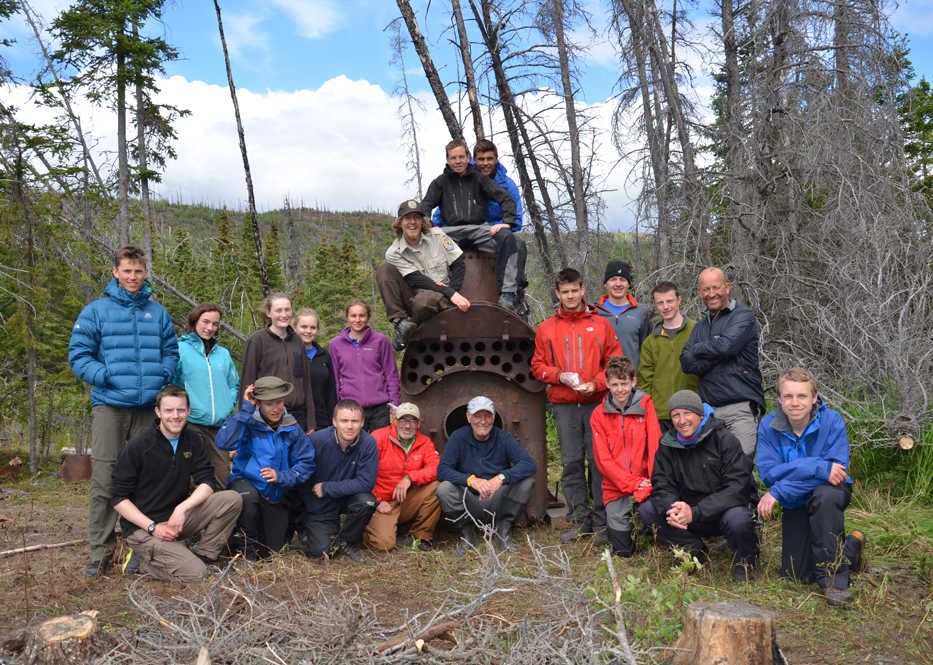In the summer of 2006 I was fortunate enough to meet Gary Titus and so began the story of this trans-Atlantic partnership between the Kenai National Wildlife Refuge in Alaska and Banchory Academy in Scotland.
Back in 2006 I was Depute Rector (vice principal) of Banchory Academy and I had travelled to Alaska with a group of 12 senior students to climb on the Harding Ice Field and to undertake some volunteer work with the U.S. Fish and Wildlife Service.
Gary, the Refuge historian and cabin restorer, was our main contact and I think he sized us up pretty quickly. One of his first questions of us was, “are you guys up for a full-on experience?” My reply was an immediate “of course” and we were off… off to Tustumena Lake and some of the most amazing volunteer conservation work in some of the most stunning country I’ve known or heard of. That first visit was such a success that it spawned two more in 2010 and 2014. Each trip built on the successes of the last and the projects become ever more demanding, with friendships cemented over the period.
During that first summer in 2006, we worked on two projects at Moose Creek on Tustumena Lake. The first involved restoring the historical sauna at the creek’s mouth. We lifted the cabin to remove and then replace the bottom three tiers of logs. The replacement logs were fashioned with hand tools from freshly-felled trees using the same techniques as the original settlers. This was a hugely-challenging but amazingly-rewarding project that was overseen by Gary in such a way that we all felt we had done it! We also repaired and “upgraded” the Moose Creek trail that leads to the Tustumena Bench.
We returned in 2010, again travelling to Tustumena Lake to work on the cabin of Andrew Berg, a famous local trapper. We reroofed the cabin with the same tin shingles that Andrew used when he built the cabin at the beginning of the last century. Some hard work, great fun and developing friendships saw the project through to a satisfactory conclusion. We also cleared the Emma Lake Trail, from its mouth on Tustumena to the Emma Lake cabin on the Bench.
This past summer followed a similar pattern, with Gary as our contact, our mentor and our field manager. As we travelled to Anchorage in late June we had an inkling of what was in store for us. We were headed back to the Home Cabin and Gary told us we were raising it up onto blocks … was Gary having some fun at our expense? We knew from before that he likes to have fun, but we knew also that Gary was serious and professional in all things associated with the history of the Refuge!
After setting up camp at the nearby cabin owned and graciously shared by Jim Taylor, Gary briefed us. We were indeed going to raise the Home Cabin up onto “stilts” so as to protect it from high water. We were going to move an old steam boiler, used in a now-gone lumber mill early last century, away from the shoreline before it was lost to one of the many storms on Tustumena. We would do some further work on both the Emma Lake and Tustumena Glacier trails. With the help of a retired U.S. Fish and Wildlife Service archaeologist, Debbie Corbett, we would also do some archaeological digging on the site of the old lumber mill to help establish its history.
Gary had tools and a plan for the cabin (he’s done this type of project many times before), he had Scott Slavik and the Refuge trails crew, and he had Debbie for the archaeology. For the boiler project he had some tools but he left the plan up to us. Those first words of Gary’s in 2006 resonated in my head … “are you guys up for a full-on project?” We were then and we were again — anything the 2006 team could do so too could the 2014 team. A plan was hatched to move the 4-ton boiler with levers, pulleys and people power — all used to great effect as it was successfully transported to the safety of dry land away from the dangers of winter storms and rising water.
Three visits over eight years, involving 36 youngsters and five adults from Scotland. Hopefully we have made a small contribution to the Refuge and their staff. Their trust has allowed students (and staff) from Banchory Academy to have some amazing experiences with some wonderful people in a truly amazing part of the world — we feel immensely privileged.
I don’t want to believe that this is the end. Gary talked about a new scheme where companies, schools and organizations adopt areas of the Refuge so as to look after them. We’ll need to discuss this next phase in our partnership with Gary before he retires!
Graham McDonald retired from Banchory Academy in Scotland and is now co-owner of Venture Force Ltd. You can find more about the Kenai National Wildlife Refuge at http://kenai.fws.gov or http://www.facebook.com/kenainationalwildliferefuge.

